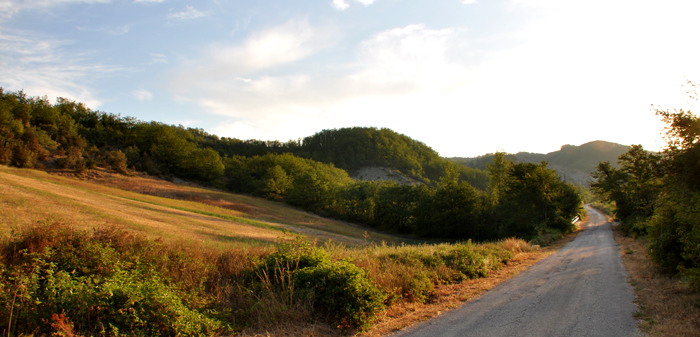alone & abandoned
August 16, 2012
13th entry – le marche 2012
This morning I finally got up early and headed down the road for a walk. (There’s an abandoned cemetery and I wanted to go shoot it.) Mornings are amazing, the sun is just rising, so you don’t get the onslaught of the mid-day heat and the bugs are sleeping. The mountains at this time of day are silent. It’s taken me all these years to finally get into the mountains. (There are side-roads off the unpaved main road, but I didn’t have the proper clothes to trek up these paths.) The pig-corn is still a wonder for me. I’ve not see anything like it in America. (I’ll have to google it and Wikipedia it and see what comes up.) I also found a wide path down to the river – a tributary of the Candigliano which in turn is a tributary of the Metauro. However, the find of the morning was the cemetery. There are less than a dozen graves left. (Ashley said that all the people buried here are from the same farm-family up the road.)
The pig-corn is still a wonder for me. I’ve not see anything like it in America. (I’ll have to google it and Wikipedia it and see what comes up.) I also found a wide path down to the river – a tributary of the Candigliano which in turn is a tributary of the Metauro. However, the find of the morning was the cemetery. There are less than a dozen graves left. (Ashley said that all the people buried here are from the same farm-family up the road.)
The cemetery has a wall around it. The wall opposite the gate has the chamber that would have been used to keep coffins in the winter. The repository chamber is open, so I went in. Inside were all these wrought iron crosses, no two are the same. (In the cemetery in Aprigliano, I was amazed when I discovered all the different crosses that topped the small mausoleums. All were different.) These abandoned crosses are made to put into the ground as markers. Given that the whole left side of the courtyard is empty, these abandoned crosses must have come from that side. (It’s not uncommon in Italy to un-inter a coffin and re-bury it in a new, better, more prestigious location. (Most of my paternal grandmother’s family in Aprigliano, has been moved from the old cemetery in to the newer section. My mother told me that as soon as they build the above-ground crypts in the Soo, many Italian families un-interred their loved ones and placed them in the above ground crypts.) I suspect that many coffins were moved from this small mountain cemetery to the new cemetery in Piobbico. The only remaining graves are on the wall to the right of the chamber. These are the graves of the Gnucci family.
On my way back, I kept thinking that landscape can shape character just as much as family. Italy, except for the coastal plains and these are narrow strips, is a country of mountains. People live in these unique communities with mountain barriers separating them. (In Pittsburgh we talk a lot about the different neighborhoods and how the topography isolates communities and how these communities have developed distinctive personalities.) Well Italy is a whole county of such distinctive communities. No wonder it took forever to unite the country. It also explains the lack of national identity and the focus on local identity. (Pittsburgh too is famous for local identities and a lack of municipal consciousness.) Italy has been dealing with one other variable that only now America is recognizing – bad central government. The lack of trust in a central government, a by-product of living in isolated communities, has added to a strong township allegiance.